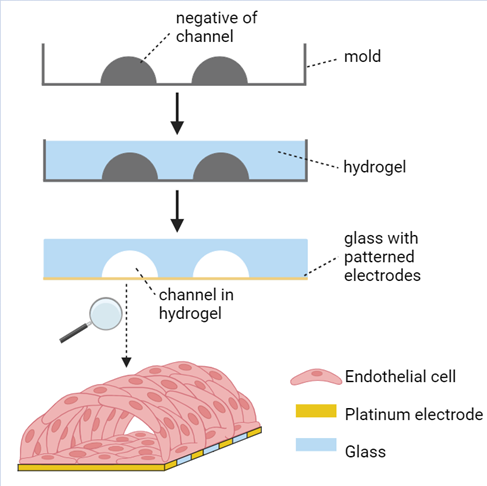The blood-brain barrier (BBB) is involved in many diseases of the central nervous system such as Alzheimer’s disease and Parkinson’s disease [1]. Due to its tightness, the BBB also hinders uptake of drugs into the brain tissue, therefore complicating treatment of such diseases [2]. Organs-on-chips (OoC) are used to model the BBB in vitro to get a better understanding of the changes to the barrier properties in disease, and how drugs can be delivered across the BBB for treatments. However, current BBB-on-chips fail to recapitulate the physiological size and microenvironment of blood vessels in the brain.
Most chip designs use permeable membranes as a substrate for the cells to grow on. These membranes hinder the interaction of cell types grown on either side, and also only allow for cell growth in a 2D plane. [3] To overcome this barrier, hydrogels may be used in the chip design. Hydrogels can mimic the mechanical and chemical properties of soft tissues, and cells grow inside the hydrogel in all three dimensions [4].
The aim of this project is to create hydrogel channels of physiological size for modelling the BBB. The work of Martijn Tibbe ([5] – Chapter 4) will be used as a basis for the project. This assignment is part of a larger project that integrates electrodes in such a chip design to allow for continuous monitoring of the trans-endothelial electrical resistance (TEER).

During this project you will:
- Use soft-lithography to create microfluidic channels in a hyaluronic-acid based hydrogel.
- Optimize the hydrogel properties towards mechanical integrity of the channels.
- Culture endothelial cells inside the channel in a co-culture with astrocytes to model the BBB.
- Perform permeability tests on this BBB-on-chip using labelled tracers.
Contact person:
References:
[1] M. D. Sweeney, A. P. Sagare, and B. V. Zlokovic, “Blood–brain barrier breakdown in Alzheimer disease and other neurodegenerative disorders,” Nature Reviews Neurology, vol. 14, no. 3, pp. 133–150, Mar. 2018, doi: 10.1038/nrneurol.2017.188.
[2] W. M. Pardridge, “Drug Targeting to the Brain,” Pharmaceutical Research, vol. 24, no. 9, pp. 1733–1744, Sep. 2007, doi: 10.1007/s11095-007-9324-2.
[3] A. Oddo et al., “Advances in Microfluidic Blood–Brain Barrier (BBB) Models,” Trends in Biotechnology, vol. 37, no. 12, pp. 1295–1314, Dec. 2019, doi: 10.1016/j.tibtech.2019.04.006.
[4] J. Thiele, Y. Ma, S. M. C. Bruekers, S. Ma, and W. T. S. Huck, “25th Anniversary Article: Designer Hydrogels for Cell Cultures: A Materials Selection Guide,” Advanced Materials, vol. 26, no. 1, pp. 125–148, Jan. 2014, doi: 10.1002/adma.201302958.
[5] M. P. Tibbe, “Improving Organ on‐Chip Physiology: Exploring the barrier in blood‐brain barrier on‐chip systems,” University of Twente, Enschede NL, 2020. [Online]. Available: 10.3990/1.9789036549301

